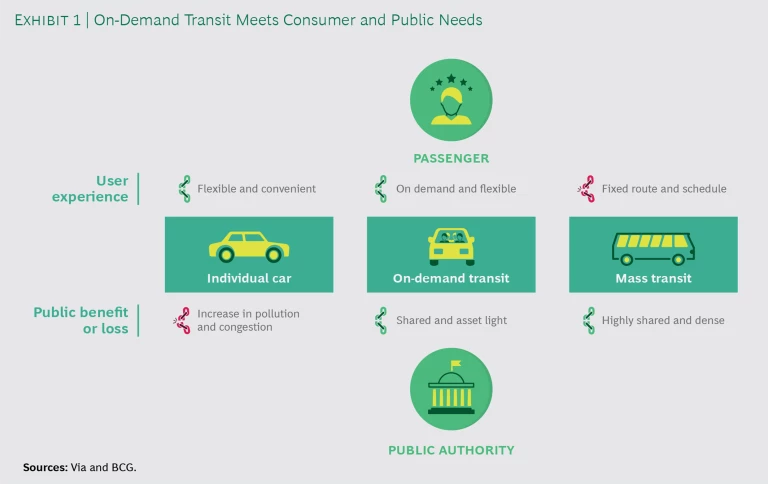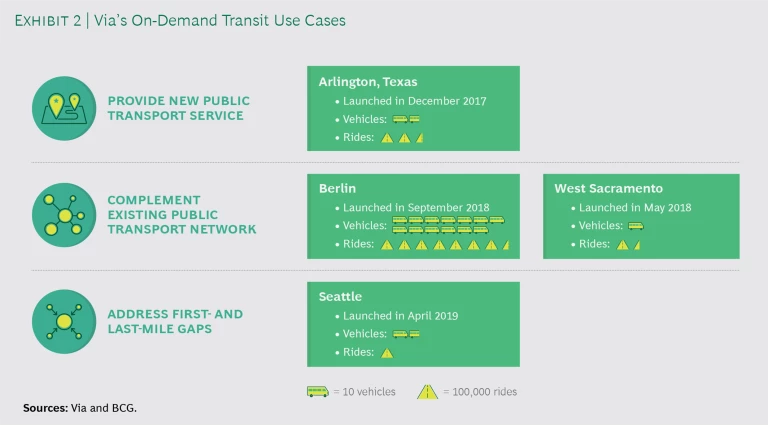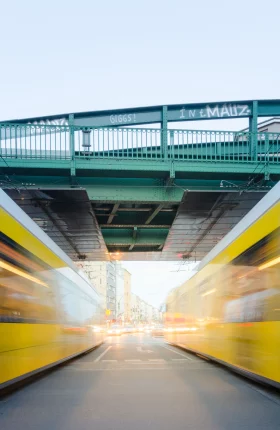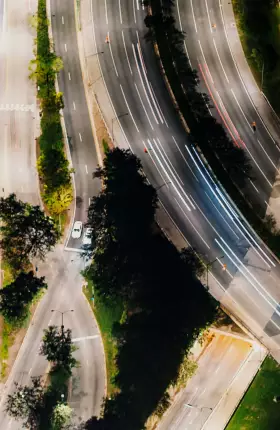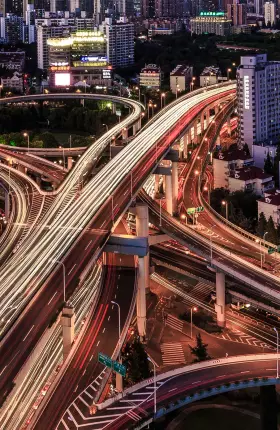This article is based on data collected and graciously shared by Via Transportation as part of a joint research program between the company and BCG.
For a century, mass transit and private cars have served different needs in the urban mobility landscape. Mass transit was designed to move as many people as possible at the lowest out-of-pocket cost for passengers, while cars offered flexibility and freedom.
But neither is working effectively in most cities. As cities have grown denser and more sprawling, mass transit has become a growing public expense and an inflexible option for passengers, who resort to using private cars. This rise in solo trips increases pollution and congestion. Meanwhile, many residents of low-income neighborhoods remain unable to reach good jobs, perpetuating income inequality.
To date, travel innovation, such as ride hailing, has contributed to rather than alleviated these challenges. Ride hailing was responsible for two-thirds of the increase in traffic congestion in San Francisco from 2010 to 2016, according to an academic study .
There has to be a middle way—one that complements mass transit and allows cities to develop new travel options that reduce congestion and pollution and increase ridership. As mass transit adopts new technologies such as smartphone apps and cloud computing, that middle way is emerging.
Over the past year, we have studied on-demand transit, also known as microtransit. On-demand transit is on demand (of course), dynamically routed, multipassenger, asset light, and green (when possible) shuttle service. We studied services in four locations: Arlington, Texas, a city snuggled between Dallas and Fort Worth; Berlin; Seattle; and West Sacramento, California. Via, a New York–based unicorn founded by Israeli entrepreneurs, which develops and operates public mobility systems around the world, operates all four services under contracts with public authorities and local transport agencies.
Our study showed that on-demand transit services work. In the right regulatory context, with lower per-passenger subsidies than those provided to comparable public services, these initiatives can benefit passengers and cities alike. Their convenience and flexibility improve the user experience over fixed-route mass transit while bringing good jobs within reach of neighborhoods poorly served by the status quo. They also generate less congestion and pollution than solo passenger travel. (See Exhibit 1.)
The Quality and Performance of the On-Demand Transit Experience
On-demand transit sits between traditional public transit and private ride hailing in convenience and flexibility. Travelers use their mobile phones to request a ride. They then walk to a nearby corner, known as a virtual bus stop, where they are shuttled with other travelers to a corner close to their destination. (Riders without smartphones can call a hotline; the unbanked have non-credit-card payment options; and disabled passengers receive door-to-door services.)
The initiatives were designed to provide a public transportation solution that did not exist (Arlington), to complement existing infrastructure by filling in gaps in the mass-transit map (Berlin and West Sacramento), or to offer first- and last-mile coverage to nearby stations and stops (Seattle). The largest of the four, in Berlin, operates 130 gas and electric vans and 5,000 virtual bus stops, while the smallest, in West Sacramento, operates 10 gas-fueled vans. (See Exhibit 2.)
The study analyzed the quality and efficiency of the services compared with ride-hailing services and fixed-route bus lines and how the new services affected the existing public transport network.
Quality of Service. Travelers, especially those in the US, still prefer the convenience of private cars to trains or buses. They also do not like to walk. Recent efforts to redesign public bus networks, moving from a hub-and-spoke to a grid design to increase convenience, have not changed the dynamics. In fact, analyses of seven US cities showed that ridership and operating performance actually declined following redesign.
On-demand transit may be the redesign effort that fundamentally changes the equation. By placing a virtual bus stop within a block or two of a traveler’s departure and arrival points, on-demand transit fundamentally improves the user experience. In Berlin, for example, the estimated time of arrival for a van at a nearby stop is less than 9 minutes, slightly faster than the interval between buses during peak times on high-volume routes. These virtual stops are closer to the doorstep than most public transit stops, and the rides never involve a transfer. In Arlington and West Sacramento, the average estimated time of arrival for a van—12 minutes—is longer than the 3- to 6-minute average arrival time of a ride-hailing service, but much faster than a typical mass transit schedule.
Efficiency of Service. The best measure of the performance and efficiency of on-demand transit is the average number of passengers that each van carries in an hour. This number ranged from 3.6 to 4.3 in the four Via initiatives we analyzed. By comparison, in the US in general, similar demand-responsive services—such as those offered in suburban and rural areas—have an average utilization of 1.9, only slightly better than the average occupancy for private cars and vans (1.6, according to the US Department of Transportation).
With a cost per ride of $8 to $11, Via’s longest-running on-demand services that we studied, in Arlington and West Sacramento, are far less expensive than the US national average of $38 for traditional demand-responsive services.
These services are also lean. The fare box recovery ratio—the percentage of capital and operating expenses covered by fares—in West Sacramento is 20%, 2.5 times greater than the national average of 7.5% for similar, demand-responsive services. It is also higher than the ratio of 19.2% for fixed urban bus routes, which are far less flexible, in the US.
Complementing Rather Than Competing with Mass Transit. Unregulated or lightly regulated ride-hailing services generally compete with rather than complement mass transit. A study in the Boston metro area conducted by the regional planning agency, for example, showed that more than 40% of passengers would have taken public transit if a ride-hailing service had not been available and 12% would have walked or biked.
On-demand transit services, on the other hand, can improve mass-transit usage when operators and local authorities work together. Services dedicated to the first and last mile, such as Seattle’s Via to Transit service and a similar pilot in Los Angeles, provide rides to and from public transit stations. Seattle riders can travel seamlessly using their light-rail fare card in Via vehicles. Even the more generic zonal on-demand transit services, meant to provide better transportation coverage, are helping to feed passengers to mass transit. In Arlington, 27% of the trips have been to or from the regional commuter rail station.
On-Demand Transit’s Socioeconomic Footprint
Based on our analysis of these four initiatives, on-demand transit has great potential to reduce congestion, pollution, and social inequality. Realizing that potential will require an artful mix of regulation and cooperation and a willingness to experiment .
A Decrease in Congestion. Congestion is costly for all participants in a city’s economic life—the city itself, employers, employees, and even the ride-hailing services. In the Dallas–Fort Worth–Arlington area, for example, drivers are stuck in traffic an average of 45 hours a year. It’s no wonder that New York City is imposing congestion pricing on vehicles in parts of Manhattan and taking steps to reduce the time that for-hire cars spend cruising for passengers.
By pooling passengers, on-demand transit services can go a long way toward reducing the number of vehicle miles traveled. In Arlington, for example, the service helped eliminate nearly 400,000 miles of travel that would have occurred if the passengers had driven solo, corresponding to a reduction of 36% of total vehicle miles traveled.
Even more encouraging, these services are used more during rush hours, so they do the most good during the most congested parts of the day. At rush hour, for example, the Arlington service averages 7 passengers an hour; Berlin, 9; and Seattle, 14—far higher than the overall average of about 4 passengers an hour. At rush hour in Berlin, just 3% of Via’s vans have only a single passenger.
That is just the start. Through a massive expansion in large cities and sharp regulatory changes to discourage personal ownership of cars, on-demand transit could help cities reduce traffic by 15% to 30%.
A Decrease in Pollution. Transportation accounts for 29% of US greenhouse gas emissions, and within transportation, cars and vans generate 59% of greenhouse gas emissions. The fight against climate change will not be won without removing gas-powered cars from the streets and without a strong push toward green, shared modes of transportation.
On-demand transit can be a powerful ally in this effort. Despite using gas-powered vans, the West Sacramento and Arlington services annually save an estimated 60 and 150 tons of CO2 emissions, respectively, by aggregating passengers into shared vehicles and eliminating solo trips.
Let’s put those savings in context. Via’s 18 vans cover only 25 square miles of the vast 9,000-square-mile Dallas–Fort Worth–Arlington area. Operating in just 0.28% of the region, Via was responsible for 0.45% of regional emission reductions, making it nearly twice as effective as other efforts. With a larger fleet, on-demand transit could probably have a significant impact on emissions reduction.
How Mobility Creates Opportunity. Transportation is vital not just to the economic health of cities but also to the living standards of their citizens. A recent BCG study in Paris showed that residents in the wealthiest 10% of neighborhoods have access to three times more qualified jobs via public transit than residents in the bottom 50% of neighborhoods.
First- and last-mile on-demand transit tackles this disparity head-on by expanding public transit options beyond walking distance from stations. The economic, employment, and cultural centers of cities become accessible to remote regions.
In Seattle, the Via pilot, just launched in April 2019, provides rides to and from five light-rail stations for the price of a trip on a public bus. With a fleet of 18 vehicles, an average 4.2 rides per vehicle per hour, and 100,000 rides in about six months, the pilot has already exceeded expectations. About 70% of the trips are longer than one mile. These trips opened opportunities to people unable to travel before, cut down on overall trip time for travelers who had walked to the stations, or took a car off the road.
Convenience, Regulation, and the Common Good
These four case studies demonstrate on-demand transit’s efficiency, quality of service, and impact on congestion and pollution, even when operating on a limited scale. They also dispel the myth that passengers prefer the convenience of car travel. But what would it take to maximize the social and environmental benefits of on-demand transit and operate at scale?
Experiment. Pilot and test all aspects of on-demand transit in new large cities—as first- and last mile-services to fixed-route transit, as an alternative to fixed routes during off-peak hours, in remote neighborhoods, as a replacement for chronically underperforming fixed routes, and so on. While on-demand transit has proven its value in many cities, every place is unique and can benefit from intelligent and well-resourced experimentation.
Integrate. Bring the existing mass-transit network as close to the doorstep as possible by folding on-demand transit into the existing system. Create a seamless, hassle-free travel and payment experience.
Regulate. Create an ambitious regulatory framework with a mix of positive and negative incentives to encourage transit ridership. A positive incentive might be reallocating funds from capital to operating expenses to promote the expansion of on-demand transit. Ballot measures could also help give public authorities the authority to increase on-demand transit funding. Negative incentives could include new taxes on personal-vehicle usage and nonpooled ride sharing along with congestion pricing, in line with what large cities such as Singapore, London, and (soon) New York are doing.
The sort of regulation that unleashes on-demand transit may be hard to imagine in the current political context of many nations, especially the US. But the existing system is unsustainable. Clogged streets and rising emissions are strangling economic and social opportunity. It is time for cities to take back their streets.
This article is the third in a series on the future of mobility. In subsequent publications, we will explore other options available to cities, drawing on the findings of our research; we welcome the input and participation of cities and private players.
The BCG Henderson Institute is Boston Consulting Group’s strategy think tank, dedicated to exploring and developing valuable new insights from business, technology, and science by embracing the powerful technology of ideas. The Institute engages leaders in provocative discussion and experimentation to expand the boundaries of business theory and practice and to translate innovative ideas from within and beyond business. For more ideas and inspiration from the Institute, please visit Featured Insights .

